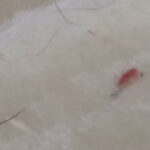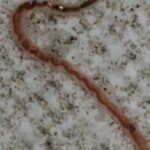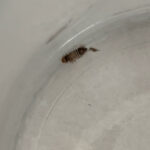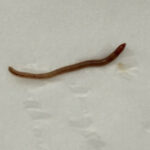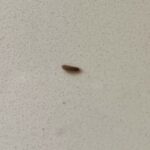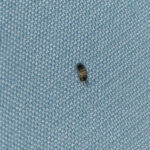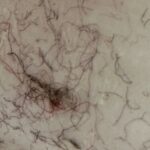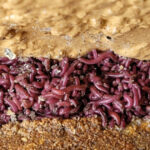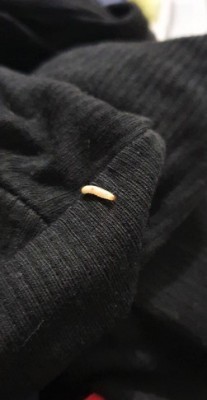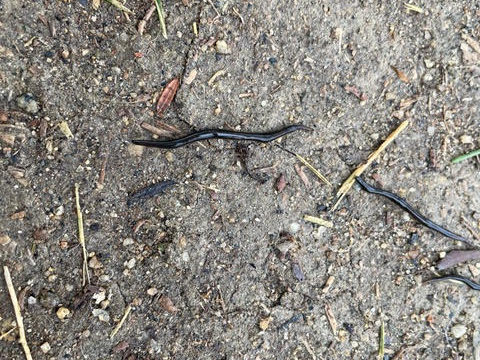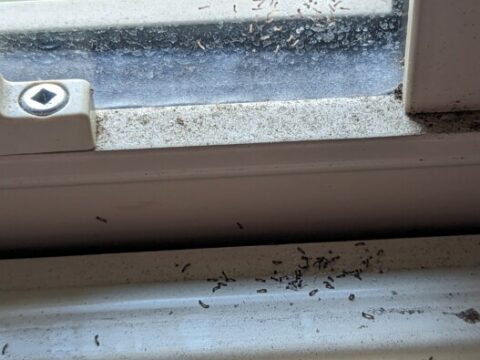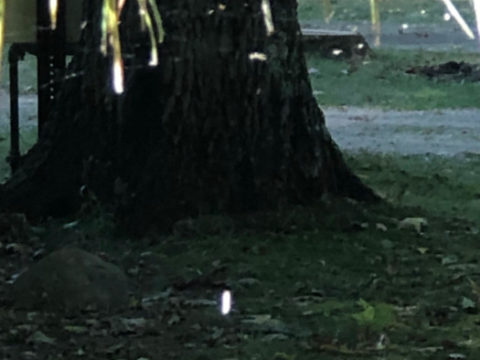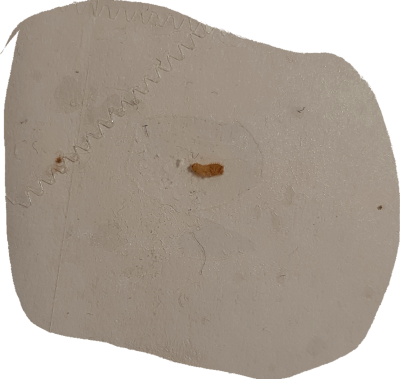
“These creatures are found on the bathroom floor” says this reader about the light brown larva-like organism in the photographs below. She states that she has been finding “more and more of these creatures” in her Michigan apartment, and that she would greatly appreciate any assistance we can provide.
Although the “creature appears yellowish-brown in the photos”, our reader reports that they are, in fact, “more of a reddish color.” Our reader lives on the top floor of an apartment complex and has been finding these critters in her home for the past three-to-four months. Our reader poses several questions in her submission, which we will go through one-by-one and do our best to answer. Firstly, she asks what the name of this creature is. Oddly enough, this simple question is the one that has us stooped. Based on the photos alone, there are factors about the bug’s physical characteristics that make it difficult for us to land on any one identification, but also knowing that it is actually more of a reddish color confuses this process even more. The most likely identification that we can provide is that this is a carpet beetle larva. This is based on its shape, bulbous head, stripes, and bristles that we can see on the tail-end of its body. What makes us unsure of this identification is that carpet beetle larvae tend to be striped all over, and not just on their rear, and they also tend to have bristles all over; if it were possible, we would presume that this critter is a half carpet beetle larva. Alternatively, we considered identifying it as a mealworm, though in that case it would also have more stripes, and the shape is also not right. Either way, we are certain that this is indeed some kind of larva, which answers our reader’s second question: “will it morph into something else?” A larva is a creature that will later mature into an insect of some kind (a moth or a beetle, for example), so it will indeed “morph into something else.”
Now, given that it is a larva and that it is red, there are other identifications to consider. We thought it could perhaps be a red midge fly larva, as they tend to show up in people’s bathrooms, but their physical appearance does not really match, whatsoever, with the larva our reader found. On top of that, it does not look like any other type of bloodworm that we know of. So, why is it red, and why has it shown up in our reader’s bathroom? One possible explanation we found was from an article about a parasite that turns caterpillars red in order to ward off predators. This could potentially be why this larva is red, and, were it to be a carpet beetle larva, then it would normally be the light brown shade we see in the photo. From what we have gathered, this parasite (which is a type of nematode/roundworm) is not dangerous to humans, and is even commonly used by gardeners to get rid of pests, so our reader has nothing to fear if this is the case. Now, we cannot say for certain if this is the case, and we do not encourage our reader to find out, as it involves cutting open the larva. Of course, even though the nematode is not dangerous to humans, we cannot promise that the larva is not. If it is indeed a carpet beetle larva, then it is not harmful, but in the case that it is something else, then we urge our reader to take precautions. So, to answer our reader’s third question (“are these creatures dangerous or poisonous?”), we cannot say for certain. We recommend that our reader use gloves and a dustpan if/when moving the larvae outside (which is what we recommend doing upon finding any roaming larvae). That said, this larva does not resemble any dangerous/poisonous larvae that we know of, but our reader should take this with a grain of salt and still be cautious. Even when a creature is not poisonous, allergic reactions can occur when one makes direct skin-to-skin contact with them.
Moving on, our reader also asks if we know what attracted/could attract this larva to her bathroom. In most cases, bugs/larvae will show up in someone’s bathroom because it has been neglected for a period of time. This could mean that it has not been used (people can sometimes find creatures in their toilet after coming home from a vacation), or that it is not being regularly cleaned. As a result, organic matter builds up in the drains and starts rotting over time, which can attract a number of creatures. If this is a carpet beetle larva, then the fabric in the towels or carpets will have attracted the larva, and to prevent infestations of such pests one needs to vacuum their home consistently. This leads us to our reader’s next question, which is if we think that this “sounds like the start of an infestation.” We would say that it does sound like an infestation, potentially one that is already ongoing, given how long our reader has been finding the same type of bug roaming her home. Lastly, our reader asks for a “permanent fix” to this issue, as she wants her home to be free of these creatures, which is understandable. Now, regardless of what species of larva this is, there are general methods one can use to combat infestations which apply to any species. We cannot promise that they are a “permanent fix”, but they do help control, and eventually eliminate, the infestation. That said, if the infestation does get out of hand, and becomes unmanageable, then we recommend that our reader call pest control (or some other professional) to deal with the issue.
Some of the things one can do to control, eliminate and prevent infestations of various bug species include: 1) Consistent housekeeping. This means cleaning the drains in one’s home often (once a week is best), sanitizing surfaces in kitchens and bathrooms, vacuuming, and keeping rooms well-ventilated. 2) Searching for roaming larvae and immediately moving them outside. This will not only limit the number of larvae already present in the home, but it will limit the number of potential larvae that can later be born, as one is eliminating mating partners. 3) Keeping leaves, twigs and other organic debris away from the walls of one’s home. Naturally, this may not apply as much to our reader, who lives in an apartment complex, but if she has a balcony, then this may still be a valid tip. 4) Laundering all clothing items and textiles that are made from organic materials (even partially). 5) Storing barely-used/occasionally-used garments in vacuum-sealed bags or other types of airtight containers. 6) Steam-cleaning carpets and upholstery. Of course, this method is only applicable to those with a steam cleaner. We should also mention that one should check the instructions for any item of furniture before steam cleaning it to make sure that it can withstand this treatment. 7) Storing grains in see-through containers, rather than keeping them in their original packaging. Such a container is better at keeping out and in creatures, so kitchen pests do not spread other food items. In addition to this, a see-through container will allow one to see if an infestation is starting at all.
To conclude, we are not entirely sure what this larva is. Our best guess is that it is a carpet beetle larva, though given the room it was found in, its physical appearance, and its color, we do doubt this conclusion. Even though we were not able to provide our reader with a concrete identification of the larva, we hope that the advice listed in this article is nonetheless helpful. If there is anything else our reader is wondering, she is welcome to contact us again or write in the comments section below. On a similar note, if any of our other readers have any other ideas as to what this larva could be, please feel free to share them in the comments section as well. We wish our reader the best!
All About Worms is always free, always reader-supported. Your tips via CashApp, Venmo, or Paypal are appreciated! Receipts will come from ISIPP Publishing.
You might also find these guys interesting!






